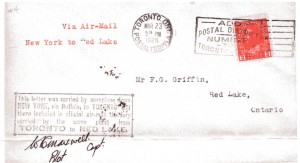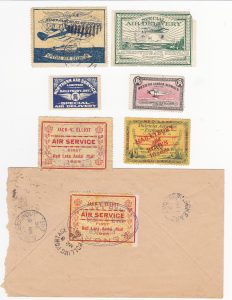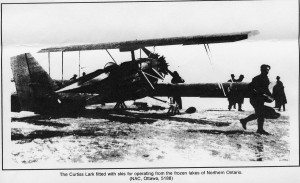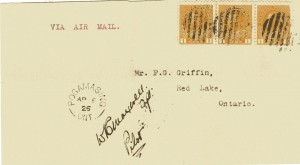How Lake Pogamasing Became Involved in Air Mail History
There were other stories about Pog that were unusual, such as the landing of two balloon race participants in an international balloon race in 1910. Fortunately, they landed near the CP line and found an easy exit. However, the next group of fliers had to wait a few days before they could exit Pogamasing. This story happened in April 1926, and it involved a maiden voyage of a Curtiss Lark from New Jersey to Red Lake Ontario. But as I learned later, there was more to the story that was in the Toronto Star reporting of it.
From New York to Red Lake, With a Stop-Over on Pogamasing
On April 3, 1926, the Toronto Star reported that an airplane was forced to land on a frozen Lake Pogamasing due to engine failure. The downed aircraft, a Curtiss Lark, was being flown from New York to Red Lake in northwestern Ontario. The flight was expected to take a few days, but bad weather intervened at every stage of the flight, and the flight ended up taking three weeks.
Red Lake, in northwestern Ontario, was experiencing a gold rush in the 1920s. It was said to be as big as the Yukon gold rush of 1898, so a flood of prospectors and mining companies descended on the area. To give themselves a competitive advantage, mining companies bought airplanes for exploration work. In late March 1926, the Patricia Airways and Exploration Company, owned by the famed Doc Oakes, had purchased a Curtiss Lark and arranged for it to be flown from New York to Red Lake.
The flight left New York on Sunday, March 21, 1926, and was flown by Casey Jones, a Curtiss experimental pilot. He was accompanied by a Toronto Star reporter, Frederick Griffin, and Roy Maxwell, a former First World War pilot and then head of the Department of Lands and Forests Air Service, who was to fly the Lark from Toronto to Red Lake. They landed in Buffalo but were forced to remain there for three days due to bad weather before they left for Toronto on March 25. They landed at Leaside, a suburb of Toronto, to prepare for the flight through the uninhabited area of Northern Ontario. Sammy Tomlinson, a flight engineer replaced Jones in the crew. (Airplanes of the time were still too unreliable to fly without an on-board mechanic.) Since it was still winter in Northern Ontario, they added survival gear of sleeping bags, snowshoes, and five days of rations. To keep his face from freezing in the open cockpit, Griffin wore an “ape-like leather face mask.” They were to take off for Sudbury on the morning of March 29 but were delayed until 3 pm, because of the weather. They finally landed at 6:30 pm on Lake Ramsey in Sudbury, just as the sun was setting. The Canadian Air Board inspected the airplane, and the wheels were replaced with skis.
Nothing was mentioned in the Star articles about one other purpose of the flight, perhaps because it was a guarded one — the use of airplanes in the gold rush in the Red Lake area with the inauguration of an airmail service for the area. The Canadian government was promoting airmail service and was authorizing airmail service to all parts of the country. To take advantage of the opportunity of the Lark delivery, postal officials authorized the airmail service and created a cachet stamped on the envelope that read “THIS LETTER WAS CARRIED BY AEROPLANE ON OFFICIAL MAIL – CARRYING FLIGHT FROM TORONTO TO RED LAKE.”
A cachet was also used for letters that were sent from New York to Red Lake. These first covers, which were envelopes with postal markings, were popular with stamp collectors and dealers. They were genuine if they met the following requirements: authorization by the Post Office, correct postage, and a stamp cancel that included the departure point and date. Additional markings that also could be added to the cover included a cachet, text, and pilot signature.
 Cover with cachet, cancelled stamp, and pilot signature, courtesy of E. O’Callaghan
Cover with cachet, cancelled stamp, and pilot signature, courtesy of E. O’Callaghan
The Post Office usually announced these inaugural flights ahead of departure to enable stamp collectors or dealers to send their self-addressed letters to the departure points for the flight. Once the flight had reached its destination, the destination stamp was marked with the date on the back of the envelope. The covers were returned to the senders or delivered to the addressee to add to their collections.
This is where the New York to Red Lake story has an interesting twist and a connection to our Pog story. Neither Pogamasing the CPR stop, nor the lake, was included in the original flight plan. However, the CPR stop ended up being recorded as one of the official covers of the New York to Red Lake inaugural airmail flight, all due to bad weather, and an enterprising reporter.
The Lark experienced difficult weather in Sudbury and was held up by a blizzard for four days. Finally, Maxwell decided to leave around 3 pm from Sudbury on Good Friday, April 2, with hopes of reaching Biscotasing that night and Red Lake by Easter, only two days away. Over Whitewater Lake, Maxwell was forced to bring the plane down from his normal elevation of 2,000 feet to 500 feet because of carburetor icing, which could lead to engine failure. Soon after, heavy snow and vapour clouds forced him down on Vermilion Lake.
Tomlinson checked the engine and once again they were off and back up to 2,000 feet. But things got nasty and the flight almost ended, as Griffin wrote in his article of April 3: “The Lark fought a sturdy fight against the elements yesterday afternoon, which ended only with our second forced landing. It was a battle all the way from Sudbury, a hundred miles or so, counting our back and forth maneuvering: part of it through bleak hill country with a fast failing engine and nowhere to land the plane because the lakes were few and far between. If we had had to come down anywhere among those dark raw hills that intervened between Windy Lake and Pogamasing Lake, we would surely have been out of luck; but Roy Maxwell’s piloting won through. He fought the ship and he fought the weather and settled as safely on the big lake with almost a dead engine.”
In fact, the propeller was turning so slowly Griffin reported that he could see the blade turning. As Maxwell brought the plane to shore on Lake Pogamasing, he noticed a man running out to meet them. It was highly probable that this was the first plane to have ever landed on Pog, and the unforeseen and extraordinary visit brought Jimmy Dwyer, a trapper, and fire ranger, Tom Kingston (dam keeper), and Jack McEwen (an employee of Cleveland-Sarnia Saw Mill Co.) and his wife and two children, out to meet them. The unexpected visitors were fed and offered a warm bed for the night. The air travellers were lucky these residents found them because the poor weather kept them on Lake Pogamasing for another three days. So much for getting to Red Lake by Easter.
After their takeoff from Pog, the flight experienced rough weather again until it reached Red Lake on April 10 and delivered the aircraft to the Patricia Airways and Exploration Company. The 1,600-mile flight should have taken sixteen hours flying time with good weather. Instead, they were delayed at every stop from New York and, as a result, the flight took twenty days.
Of the four postal covers that I have copies of, three were written to F.G. Griffin, the author of the Star article. Griffin must have been a stamp collector and wanted the covers to mark the inaugural airmail flight. Two were post-marked from Toronto, one from Sudbury, and one from Pogamasing. I sense that Griffin took advantage of the situation and decided to create a Pogamasing cover to add to the other starting points, New York, Toronto, and Sioux Lookout. Since there was no post office at Wye until December of 1929, Griffin went to Pogamasing — a distance of two and a half miles southeast of Wye — where they were a post office and a telegraph operator who could send his story to the Star. As a stamp collector, he knew that a Pogamasing cover would be rare, and therefore valuable. So he took the opportunity to add 20 covers along with the ones from the three previous stops: 45 from Sudbury, 131 from Toronto, 45 from New Jersey, and later, 25 from Sioux Lookout. Griffin was correct about the value of the Pogamasing covers, as they were listed at over double the Toronto price ($175 versus $75) in The Air Mails of Canada and Newfoundland.
Cover that Tornto Star Reporter Fredick Griffin sent from Pogamasing, Courtesy of K. Tischler
The story of the flight can be seen in back issues of the Toronto Star from March 20 through to April 13, 1926, without a word about the stamp covers. I would never have learned of this had it not been for a serendipitous circumstance.
In April, 2006, Bill McLeod wrote a review of Kay Ward’s book, Pog Tales, for the Sudbury Star. Edward O’Callaghan read the review and called Bill because of the mention of Lake Pogamasing. O’Callaghan is a stamp collector and knew that Pogamasing had been one of the covers created as a result of the inaugural airmail flight. Through Bill, I got in touch with O’Callaghan, who told me about the story. He sent me three copies of various covers associated with the flight and gave me the name of a stamp club colleague, Kurt Tischler, whom he thought might have the Pogamasing cover. Kurt was as generous as Edward and sent me a copy of the Pogamasing cancel (see above) and several photos of the Lark. So thanks to Edward O’Callaghan and Kurt Tischler, we learned how Pogamasing came to be included in the inaugural airmail service, if only due to poor weather and an opportunistic reporter who was also a stamp collector.
There were many other air services across the country as I discovered first from Robert Galway and then when I looked at a stamp collection my son Fraser, inherited from his grandfather Dick Taylor, of New Liskeard. In the book were several of the many stamps air services issued to pay for the airmail service. Patricia Air services also issued their own stamp is in the second row, third from the top.

For more information on the airmail service and early bush planes in northwestern Ontario, follow the link to The Semi-Official Air ail Stamps of Canada http://www.semiofficials.ca/index.html




{ 4 comments… read them below or add one }
I enjoyed this article very much! I am a stamp collector as well and have the cover from New York to Red Lake, along with the enclosure wishing Captain Maxwell good luck on his flight to Red Lake. I find the additional information on the Pog flight fascinating.
Regards,
Steve
Hi Andy;
I see that Steve Johnson was in touch with you re”Roy Maxwell’s Flight of the Lark to Red Lake in 1926 via “Pog”.
I was in Red Lake in July after an absence of 30 years.
Are you in Toronto, if so maybe we can meet over a coffee?
I am just starting the construct of a new website related to a book I just published. (last topic on the menu)
regards
Robert Galway
Robert Galway
416 76209270
Thanks for publishing this story.
Sammy Tomlinson was my great uncle and it’s really quite wonderful to hear of his exploits in Canada. These chaps were pioneers in every sense of the word.
My next challenge is to improve my knowledge of Canadian geography…
Yours appreciatively,
Phil Tomlinson.
Thanks for your comment Phil. Funny it should come just after I was at a presentation by Bob Galway on Tuesday who included this story as part of his presentation. If you check out this website – http://www.semiofficials.ca/index.html – you may find other stories. Bob knows a great deal about aviation, and air mail service, especially as it relates to the Red Lake gold rush.
Andy